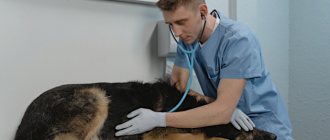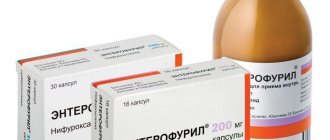The dog has bloody diarrhea. Let's understand the reasons. Medicines that will help. Is the course of treatment long? Manipulations that will be performed in the clinic.
Diarrhea (diarrhea) is a very common problem in dogs. There is hardly an owner who has never encountered this. But few people know how to determine how serious it is. When to see a doctor and when to get help at home.
Particular attention should be paid to the fact that diarrhea is not a disease, but a symptom.
Bloody diarrhea: Causes and treatment (Dog has diarrhea)
Loose stools occur in dogs due to impaired absorption of fluid in the large or small intestine, including due to irritation of its walls. Blood appears due to tissue damage.
Moreover, it is worth noting that scarlet impurities in feces are detected when the integrity of the walls of the large intestine is violated. Dark, almost black, stool appears when the small intestine is traumatized.
The main causes of diarrhea with blood:
- Eating foreign objects . Often dogs eat inedible things not on purpose, but in play or because of the attractive smell and taste. Sometimes perverted appetite is associated with chronic gastritis, for example. Foreign objects include thread, plastic bags, bones, toys and more. There have even been cases where dogs swallowed the spoon with which they were given a treat. Being in the gastrointestinal tract, these objects can cause inflammation, necrosis and even perforation of the walls. In this case, one of the symptoms may be diarrhea with blood if partial intestinal patency is preserved.
- Poor quality feed . Stale food that has been stored for a long time or improperly can also cause enterocolitis and lead to bloody diarrhea.
- Parasites . Roundworms or tapeworms in the course of their life activities lead to inflammation of the intestinal walls. The simplest single-celled organisms (giardia, coccidia, isospores) can also cause a negative reaction in the body.
- Viral infections . Coronavirus and parvovirus enteritis are widespread in unvaccinated animals. With the latter, in addition to blood in the stool, there may be a sharp unpleasant odor, a deterioration in the general condition: lethargy, vomiting, lack of or decreased appetite, and increased temperature. If these symptoms occur, you should contact a veterinary clinic for help as soon as possible. In young animals with these diseases, mortality is high, and the count can go on for hours. It is not recommended to buy puppies at poultry markets or from unscrupulous breeders; very often the babies end up sick. Symptoms may not develop immediately, but may take up to three weeks.
- Neoplasms . They are more common in older animals, but young ones can also suffer from cancer. The tumor can either become injured, disintegrate on its own, or provoke the occurrence of enteritis and colitis, causing diarrhea in dogs with blood.
- Chronic and acute inflammatory processes in the gastrointestinal tract of unknown etiology . Unfortunately, it is not always possible to find out the cause of bloody diarrhea. Sometimes the symptom resolves itself.
- Poisoning by poisons . Side effects of certain medications. Poisoning with rat poison often causes bleeding, and not only gastrointestinal bleeding.
Some antimicrobials, NSAIDs (nonsteroidal anti-inflammatory drugs), and other medications can cause hemorrhagic diarrhea in dogs.
Attention! You should not give human pills without the doctor’s knowledge, since in addition to bleeding, they can cause failure of internal organs, and death will not be long in coming.
Prevention
In most cases, blood in your dog's stool can be prevented. Key measures that can be taken:
- Anthelmintic treatment. Prevention medications are given once a quarter. If worms are noticed in the feces, deworming is carried out twice with an interval of 10-14 days.
- It is always necessary to monitor the animal's stool - consistency, color, presence of mucus or blood impurities.
- Proper, balanced nutrition with enough fiber. The amount of food should correspond to the weight of the dog. Avoid overfeeding. It is advisable not to give bones often.
- If an animal is predisposed to problems with the digestive tract, it makes sense to immediately transfer the pet to a special diet. They contain easily digestible ingredients and support healthy intestinal microflora.
- While walking, be careful that your dog does not pick up anything from the ground.
- Conduct annual routine vaccination against viral diseases of dogs.
Video:
What to do? The dog has bloody diarrhea
Treatment of bloody diarrhea in dogs is best started immediately. Therapy directly depends on the etiology. With such a symptom, it is better to immediately contact a veterinary clinic, since it is difficult for the owner to assess how serious the problem is.
First, the doctor will examine the animal, assess the condition of the mucous membranes, whether there is serious anemia, measure the temperature, and so on. Then he will collect anamnesis, ask you about how long ago the problem began, what you were fed, when was the last vaccination and deworming, is there access to medications, is it a chronic or acute process, and much more.
Try to be prepared to answer the doctor's questions, as this is very important.
The veterinarian will take blood from your pet for a general clinical and biochemical analysis. Conduct a stool examination for the presence of parasites. An X-ray and ultrasound examination of the abdominal cavity will be performed.
Not all studies will be ready quickly; additional diagnostics in the form of CT or MRI may be required, so the doctor will begin symptomatic treatment for now:
- Hemostatic drugs . The choice of drug will be determined by the abundance of blood in the stool and the suspected cause of its occurrence.
- Rehydration . Prescribing intravenous infusions of saline to replenish fluid in the body.
- Antibiotic therapy . Diarrhea in dogs with blood in any case requires antimicrobial therapy.
- The choice of other drugs depends on the condition of the animal, the presence of other symptoms and the suspected etiology.
If during the diagnosis it turns out that the dog has a foreign body or neoplasm that can be removed, then the condition is stabilized and surgery is carried out.
Symptoms of the disease
The presence of blood clots and inclusions in the feces of a four-legged friend is a pathological process that may indicate problems in the body.
Note! Frequent stools with blood and mucus may indicate the presence of serious disturbances in the functioning of the digestive system in the animal.
Also, bloody diarrhea may indicate the development of acute viral-bacterial, parasitic diseases and infections.
If your dog exhibits symptoms from the list below, you should immediately contact your veterinarian:
- the animal has prolonged profuse diarrhea, which can last more than two days;
- an unpleasant fetid odor emanates from the stool;
- the animal experiences vomiting and nausea;
- decreased appetite;
- the dog completely refuses to eat food and drink water;
- increase in body temperature by 1-2 degrees;
- yellowing, anemia of the mucous membranes;
- the dog vomits, it becomes lethargic and drowsy;
- manifestation of inadequate reactions to external stimuli.
If your dog has diarrhea with mucus and blood, then you should not self-medicate. Be sure to immediately contact a veterinarian. The doctor will be able to identify the underlying cause of this symptom, and he will prescribe the appropriate treatment.
A dog has bloody diarrhea: Treatment at home
If you do not have the opportunity to see a doctor, or the clinic is located far away and it takes a long time to get there, then you can use the PetStore . You can also ask questions in the VKontakte network group: https://vk.com/petstoryru
In addition, for first aid, you can drink a nettle decoction to try to stop the bleeding. To relieve inflammation, a pharmaceutical solution of chamomile is suitable. You can fix the stool and relieve intoxication with the help of Enterozoo , Enterosgel , Smecta , Polysorb , and activated carbon.
It is better to offer your pet food that will not injure the gastrointestinal tract and can be easily digested. From industrial feeds, you can offer Hills i/d , Proplan E/N , Monge and Royal Canin gastrointestinal, preferably wet or soaked dry.
You can prepare rice water at home. Add a small amount of meat for flavor. Then feed him the usual food, but in a soft state, for at least two weeks.
To enlarge the picture, click on it
What to do to avoid this
For some reason, many owners, especially those who got an animal for the first time, do not follow the basic rules that allow them to protect their pet from most health problems. And only after they are faced with an illness or even the death of a dog, do they understand the importance of the instructions.
To significantly reduce the risk of disease you need to:
- While walking, do not let your dog eat anything found on the street . It is better to choose places for walking that are far from concentrations of stray animals. Limit contacts with unknown relatives.
- Carefully select a diet that is suitable for this particular breed and do not spoil them with harmful foods too often. Do not change food suddenly. If necessary, the transition should be carried out gradually.
- Keep the dog in a dry, clean, warm room. Regularly carry out wet cleaning and disinfection.
- Do not use other people's toys or care items without first disinfecting them.
- Once every six months, undergo a preventive examination by a veterinarian.
Loose stools with blood in a dog: Prevention
It is easier to prevent the disease from occurring than to treat the dog later.
Let's talk about preventive measures to combat bloody diarrhea:
- Avoid eating foreign objects. For example, instead of a plastic duck, offer your dog to play with a toy made of durable rubber - Kong .
- Feed high-quality food from trusted sources.
- Carry out preventive treatment against parasites every quarter. Moreover, it is recommended to treat fleas every 1-3 months, since they are carriers of dipylidia (cucumber tapeworm). Drugs for endoparasites: Helmintal , Inspector , Cestal , Milprazone , Drontal , Milbemax, Kanikvantel, Cestal, Endogard, Prasitel, Procox .
- Annual vaccination against viral infections. Vaccines against parvovirus enteritis: Nobivak, Kanigen, Eurikan, Vanguard 7, Vanguard 5 plus . The latter also protects against coronavirus.
- It is recommended that animals be examined once a year: blood tests, urine tests, feces tests, and an ultrasound scan of the abdominal cavity.
- Avoid self-medication without the advice of a veterinarian.
Kong Dog Toys
Associated symptoms
Feces are a fairly accurate detector that shows whether your pet is normal. If it is light or dark brown in color, then the dog is healthy and there is nothing to worry about. But if you encounter a deviation from the norm, and even more so see bloody spots, this is a reason to immediately go to the professionals.
- If there are bright scarlet inclusions in the feces, it means that the damage is in the area of the anus or rectum, that is, there is mechanical damage to the tissue.
- If the blood in the poop is black, it means that a huge number of red blood cells are breaking down. The source of the disease is most often located in the upper gastrointestinal tract.
- Severe diarrhea with inclusions indicates severe chemical poisoning or severe inflammatory disease.
- If the stool generally turns into a mixture of mucus, blood and water, and the general condition is characterized by lethargy, depression and lack of appetite, then you should worry about contracting a viral infection, and the development of the disease is already in one of the last stages and the dog’s life hangs by a thread.
- Liquid stool with rare brown bloody spots, accompanied by severe lethargy and vomiting, indicates food poisoning from bad food or inappropriate, old food.
- If diarrhea does not go away within a day or even two days, the nose and eyes begin to run, the animal refuses to eat, and habitual behavior changes dramatically, then these are pronounced symptoms of such severe, often fatal diseases as canine distemper and viral rhinotrachiitis.
Diarrhea in a dog with blood: Where to go for help?
We have made for you a selection of clinics where you can contact with the problem of bloody diarrhea in dogs. Remember that it is better to contact a specialist immediately - a veterinary gastroenterologist.
Moscow:
- Biocontrol;
- Your doctor;
- Medvet;
- Bagheera;
- White Fang.
Saint Petersburg:
- Network of veterinary clinics Kotonai;
- Vega network of veterinary clinics;
- Network of veterinary clinics Cityvet;
- Ivan Fillmore Veterinary Clinic;
- Veterinary clinic of Dr. Sotnikov.
Krasnodar:
- Specialized Veterinary Clinic “On Babushkina”. Around the clock;
- Veterinary clinic “Big Dipper”;
- VITA. Around the clock.
Murmansk:
- Kotonai Clinic Network;
- Chain of clinics Cat and Dog;
- Clinic Favorit.
Novosibirsk:
- Best Clinic;
- Bagheera Clinic.
Khabarovsk:
- Emergency veterinary care center “Vita-Clinic”;
- Finber;
- Green parrot.
Rostov-on-Don:
- Don Veterinary Hospital;
- Hakuna Matata.
What is the danger of internal bleeding
Loss of blood leads to the development of anemia in the animal, and due to low blood pressure and constant weakness, the dog is less able to tolerate any stress on the body and becomes drowsy. Without proper care and treatment, your pet may develop problems with the functioning of its organs. The worst-case scenario is the death of your pet.
The cause of death can be too much blood loss, dehydration, intoxication and exhaustion. In all these cases, you will need the help of a specialist.
What to feed your pet with diarrhea
After the first day of therapeutic fasting, you need to wonder what to feed your suffering pet. On the first day, your pet is fed with clean water, and on the second day you can add an infusion of medicinal plants and rice water.
It is advisable to include rice boiled in water in the menu of the second and third days. As soon as the loose stool stops bothering the dog, he is treated to rice cooked in chicken or beef broth. This will help you quickly restore lost strength.
You cannot feed a lot at once, no matter how great the temptation, especially for puppies. Portions are increased gradually, as is the frequency of feeding. Feed the dog little by little, up to 6 times a day. On the second day or the day after the diarrhea has ended, you can include fermented milk products in the menu. Such food is more likely to restore the intestinal microflora.
As soon as your health improves, low-fat cottage cheese is added to your diet. On the third day, if the dog feels definitely better, he is treated to a couple of boiled eggs. White chicken meat, steamed or boiled in water, helps to restore strength.
Preventing the appearance of blood during bowel movements
Adjusting the diet to the specific breed, age and condition of the dog is an effective prevention. Every pet should take vitamins that can strengthen the immune system and eliminate vitamin deficiency. A sufficient amount of vegetables, meat, vitamins and minerals in food will help eliminate the possibility of blood in the stool.
Constant examination by a veterinarian and maintaining the dog’s hygiene will help identify the disease at an early stage and prevent its consequences.
Responsibility for the dog’s health lies with the owner, and careful attention to the pet will not allow the development of the disease. If you experience bloody stools or diarrhea, the best way out of the situation is to immediately visit a doctor. Self-medication for diseases with such symptoms is disastrous and dangerous for the pet.
Diagnostics
In a dog, bleeding from the anus can indicate a variety of diseases. Therefore, diagnosis of this condition is quite difficult.
From laboratory tests, the following methods can be used (the specific list of studies is determined by the veterinarian after an objective examination of the dog):
- General blood analysis. The results of the study will indicate post-hemorrhagic anemia (decreased levels of hemoglobin and red blood cells). If the cause of the condition is an infectious disease, then in addition to anemia, neutrophilic (if the infection is bacterial) or lymphocytic (if viral) leukocytosis and an increase in the erythrocyte sedimentation rate will be observed.
- Blood chemistry. Renal (creatinine, urea) and hepatic (ALT, AST) complexes are examined to diagnose complications.
- Stool analysis to detect helminths.
- Virological blood test, enzyme-linked immunosorbent assay (ELISA) or polymerase chain reaction (PCR) for diagnosing the causative agent of infectious diseases.
It is more informative to conduct instrumental research. The following methods are used for diagnosis:
- Endoscopic (gastroscopy or colonoscopy) to identify the source of bleeding. Endoscopy is also used if a tumor process is suspected.
- X-ray (plain or contrast radiograph) to determine the location of the lesion.
- Ultrasound examination (ultrasound) of the abdominal organs. Performed to evaluate internal organs and determine the presence of free fluid in the abdominal cavity.











